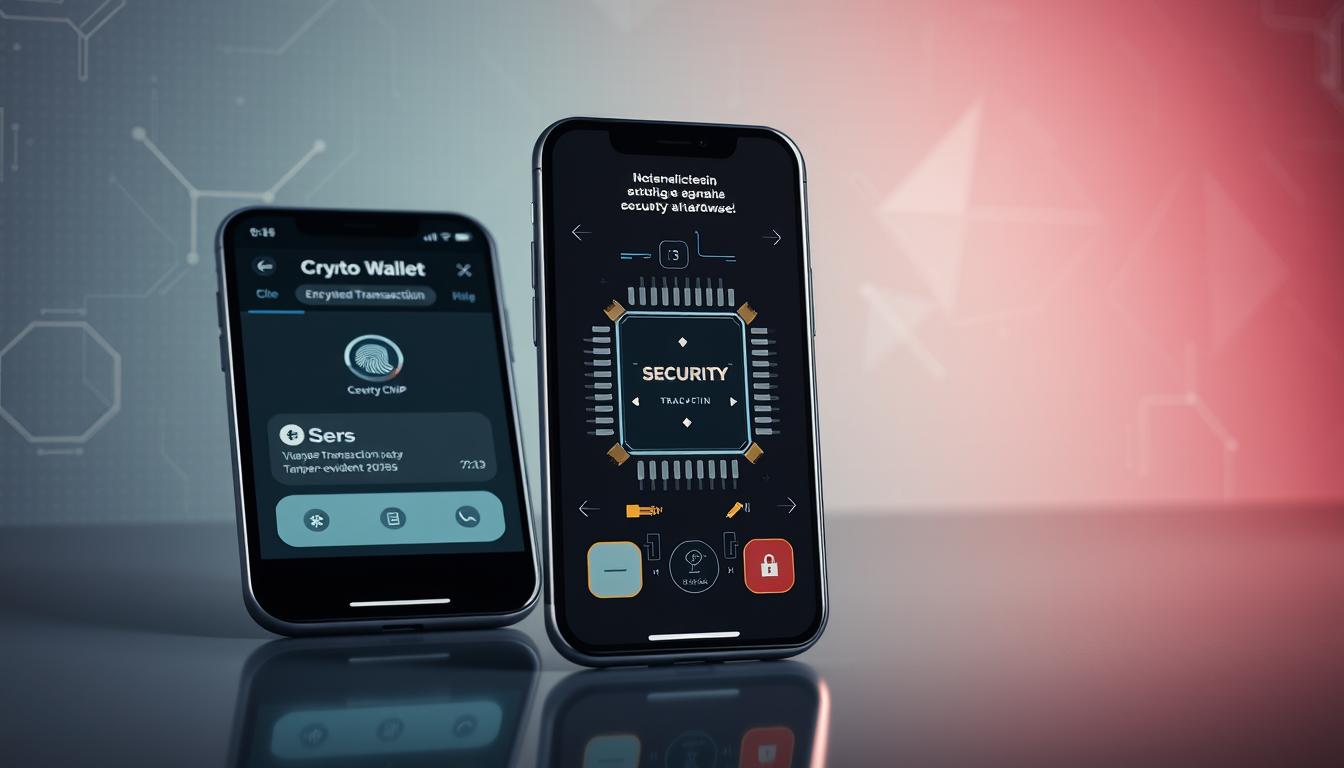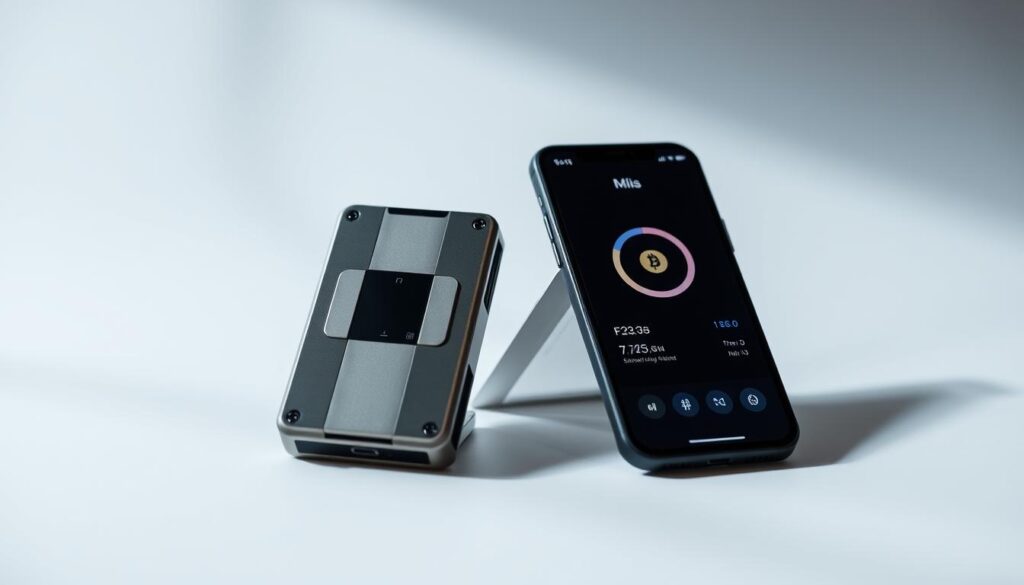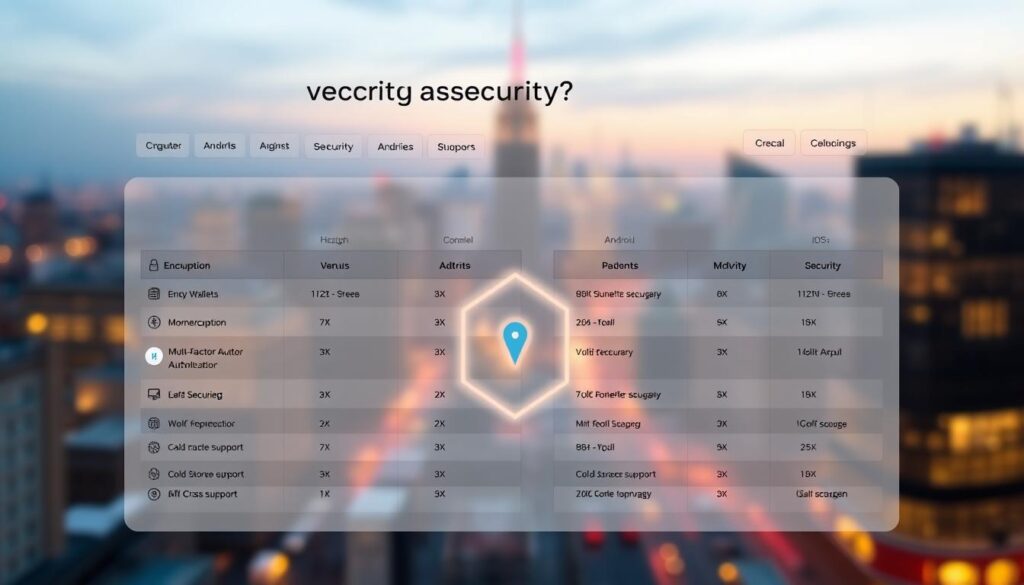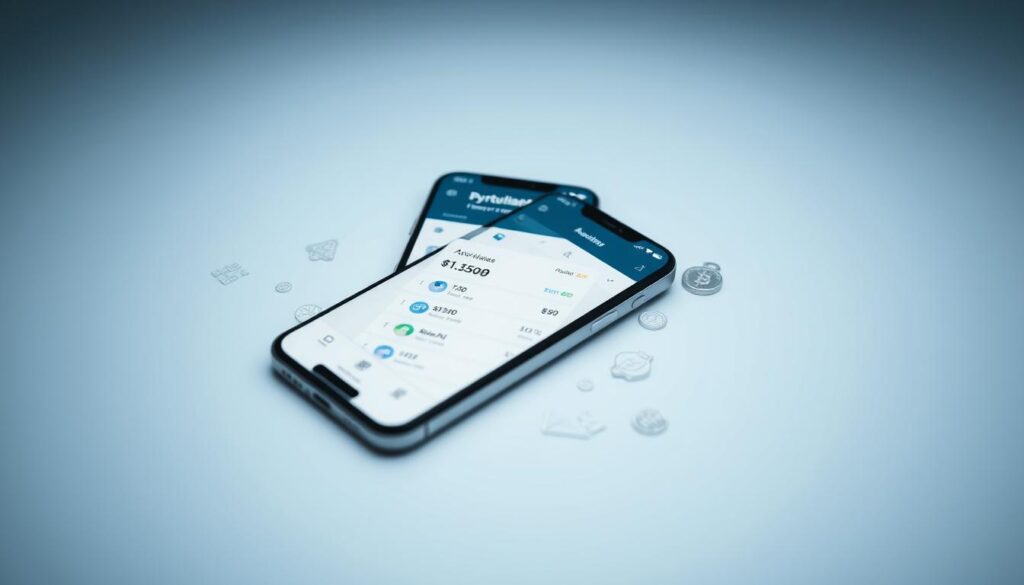Now Reading: Best mobile cryptocurrency wallets for Android and iPhone security comparison
- 01
Best mobile cryptocurrency wallets for Android and iPhone security comparison
Best mobile cryptocurrency wallets for Android and iPhone security comparison

Blockchain technology has transformed how we handle digital transactions, making them faster and more accessible than ever. However, this convenience comes with risks. As more people trade digital assets, reports of theft and fraud have surged. Protecting your investments starts with choosing the right tools.
Smartphones now serve as the primary hub for managing digital currencies. Over 60% of global internet traffic flows through these devices, highlighting their role in modern finance. This shift demands robust security protocols to safeguard sensitive data and funds.
iOS applications often lead in app-level protection, leveraging Apple’s Secure Enclave and biometric authentication like Face ID. These features create barriers against unauthorized access, while strict App Store reviews reduce malware risks. Android options, though flexible, require careful vetting to ensure similar safeguards.
This guide focuses on balancing usability with advanced protection measures. Whether you prioritize seamless transactions or ironclad encryption, understanding platform-specific strengths is key to managing digital wealth confidently.
Key Takeaways
- Mobile devices drive over 60% of internet activity, making them critical for crypto management
- Rising fraud rates highlight the need for secure storage solutions
- iOS wallets benefit from hardware-level security and strict app guidelines
- Cross-platform evaluation ensures compatibility with user preferences
- Biometric authentication adds an extra layer of account protection
Understanding Mobile Cryptocurrency Wallets
Digital keys act as gatekeepers to blockchain networks, not physical containers for coins. These tools manage access codes that prove ownership and enable transactions. Unlike traditional bank accounts, they focus on securing cryptographic credentials rather than holding currency.
Access Control Systems Explained
Two primary categories exist for managing blockchain credentials. Hot systems remain internet-connected through apps or browser extensions. They enable instant transfers and portfolio tracking. Frequent traders prefer these for their 24/7 accessibility.
Cold solutions take security further by isolating credentials offline. These physical devices resemble USB drives or engraved metal plates. Hackers can’t reach them remotely, making them ideal for long-term holdings.
Connectivity Tradeoffs
- Web-based options: Faster transactions, higher exposure risks
- Offline storage: Slower access, reduced vulnerability
- Hybrid approaches: Balance convenience and protection
Daily users might combine both methods. Keep small amounts in hot systems for regular use while storing bulk assets offline. This strategy minimizes loss risks without sacrificing functionality.
How Crypto Wallets Protect Your Private Keys
Your private keys are the gateway to managing blockchain-based assets securely. These digital credentials require military-grade protection to prevent unauthorized transactions. Modern solutions combine cutting-edge technology with user-controlled safeguards.
Encryption Techniques and Self-Custody
Advanced encryption standards like AES-256 transform sensitive data into unreadable code during storage. iOS devices enhance this protection through biometric authentication, linking access to unique biological traits. Self-custody models ensure users maintain exclusive control over their keys rather than relying on third parties.
Backup Options: Seed Phrases and MPC Technology
Traditional recovery methods use 12-24 word seed phrases that act as master passwords. While effective, these phrases create vulnerability if stored improperly. Newer systems like Multi-Party Computation (MPC) split keys into encrypted fragments distributed across separate servers. Platforms such as Zengo leverage this approach to eliminate single failure points entirely.
Self-managed wallets prioritize direct ownership, contrasting with custodial services where exchanges hold your keys. This balance between accessibility and protection defines modern digital asset management strategies.
Comparison Features: Hardware vs. Software Solutions
Asset protection strategies split into two distinct approaches when managing blockchain credentials. Physical devices and application-based systems each address different priorities for investors. This contrast becomes clear when examining their core security features and interaction models.

Physical Safeguards in Dedicated Devices
Hardware wallets like Trezor Model One ($49) require manual confirmation for every transaction through built-in screens. The Ledger Nano S Plus steps up protection with military-grade CC EAL6+ chips – technology also used in credit cards and passports. These tamper-resistant components store credentials offline, blocking remote hacking attempts.
Streamlined Management Through Applications
App-based solutions prioritize quick access through fingerprint scans and face recognition. While convenient for frequent trades, they operate within smartphone ecosystems vulnerable to malware. Advanced encryption helps, but internet connectivity creates potential exposure points absent in air-gapped hardware alternatives.
| Feature | Hardware Wallets | Software Wallets |
|---|---|---|
| Transaction Authorization | Physical button press required | Biometric approval enabled |
| Offline Storage | Full isolation from networks | Partial encryption only |
| Multi-Asset Support | 5,500+ currencies (Ledger) | Varies by application |
| Recovery Options | Seed phrase backup | Cloud or manual backups |
Investors often combine both methods – using apps for daily transactions while storing majority holdings in hardware devices. This hybrid approach merges immediate accessibility with enterprise-grade protection for diverse needs.
Best mobile cryptocurrency wallets for Android and iPhone security comparison
Third-party audits offer objective insights into wallet security effectiveness. Standardized evaluation systems like CER ratings and CertiK Skynet Scores reveal how platforms protect digital assets. These metrics assess encryption strength, vulnerability resistance, and recovery protocols.
Highlighting Critical Security Metrics
Leading solutions employ distinct approaches to achieve high safety ratings. Exodus combines traditional seed phrases with AES-256 encryption, earning an 84.25 CertiK score. Zengo’s keyless MPC technology eliminates single-point failures, reflected in its 84.71 rating.

Trust Wallet’s 85.24 score stems from regular penetration testing and open-source code verification. MetaMask leads with 89.87 points through smart contract audits and phishing detection systems. These scores help investors gauge risks across different storage methods.
| Platform | CER Rating | CertiK Score |
|---|---|---|
| Exodus | AAA | 84.25 |
| Zengo | AAA | 84.71 |
| Trust Wallet | AAA | 85.24 |
| MetaMask | AA-AAA | 89.87 |
iOS versions enhance protection through hardware-level safeguards. Apple’s Secure Enclave isolates biometric data from network access, while mandatory App Store reviews block suspicious updates. These layered defenses complement wallet-specific security measures for comprehensive asset protection.
Evaluating Security, Usability, and Integration
Modern digital asset management requires solutions that blend ironclad protection with intuitive interfaces. Developers now prioritize systems where robust safeguards coexist with seamless access to decentralized ecosystems. This balance determines whether tools remain practical for daily use while thwarting sophisticated threats.

Biometric Authentication and Secure Enclave Benefits
Apple’s Secure Enclave technology reshapes how iOS apps guard sensitive data. This dedicated chip isolates cryptographic operations from network exposure, creating a hardware barrier against remote attacks. Face ID and Touch ID add biometric verification layers, ensuring only authorized users initiate transactions.
Trust Wallet leverages these features while maintaining compatibility across devices. Its auto-detecting DApp browser adjusts settings based on network requirements. This eliminates manual configuration errors that often lead to security gaps.
Integration with DApps and Third-party Tools
MetaMask demonstrates deep platform integration through its Ethereum-based DeFi connections. Users interact with lending protocols and NFT markets without leaving the app interface. WalletConnect bridges mobile and desktop environments through encrypted QR codes, maintaining security during cross-device operations.
Key considerations for third-party tool integration include:
- Permission controls for external app access
- Automatic session termination after inactivity
- End-to-end encryption for data transfers
These features enable sophisticated functionality without compromising core protection measures. By combining hardware-level security with smart ecosystem integration, leading platforms achieve both ease of use and enterprise-grade safeguards.
Review of Top Mobile Wallets for Bitcoin and Altcoins
Managing diverse digital holdings demands tools that adapt to evolving blockchain ecosystems. Leading solutions now offer extensive asset compatibility while streamlining trading processes through integrated features.

Overview of Asset Support and Exchange Options
Trust Wallet sets the standard with cross-chain versatility, supporting 100+ networks from Bitcoin to Solana. Its automatic token detection simplifies managing ERC-20 and BEP-20 assets, while NFT enthusiasts appreciate native ERC-721/1155 compatibility. Built-in swaps connect users to multiple liquidity providers, though fees vary between 0.1%-2% depending on network congestion.
Exodus excels in portfolio management with 260+ supported cryptocurrencies. The platform integrates staking for Proof-of-Stake tokens, letting users earn rewards directly through the app. Hardware wallet compatibility adds offline protection layers, creating a hybrid solution for risk-conscious traders.
Phantom dominates Solana ecosystem transactions with instant cross-chain swaps between SOL, ETH, and Polygon assets. Its gas fee automation eliminates manual calculations during network spikes – a critical feature when trading meme coins or participating in time-sensitive DeFi opportunities.
| Platform | Key Assets | Exchange Fees | Unique Feature |
|---|---|---|---|
| Trust Wallet | 100+ chains | 0.1%-2% | NFT gallery |
| Exodus | 260+ coins | 1%-3.5% | In-app staking |
| Phantom | 6 networks | 0.85% fixed | Gas automation |
All three platforms enable direct fiat purchases through partnerships with payment processors. For those exploring leading crypto solutions, balancing token diversity with transaction efficiency remains crucial in today’s multi-chain environment.
In-Depth Look at Leading Hardware Wallets
Physical storage solutions form the backbone of secure digital asset management. These specialized tools keep credentials isolated from online threats while maintaining accessibility through modern connectivity standards. Their evolution reflects growing demands for tamper-resistant designs that withstand both digital and physical intrusion attempts.
Cutting-Edge Device Architecture
The Trezor Model One pioneered cold storage practices with its 2014 release. At $49, it combines affordability with critical safeguards like on-device transaction verification. Users confirm transfers through built-in screens, ensuring no sensitive data leaves the hardware.
Ledger’s Nano S Plus raises protection standards with military-grade Secure Element (CC EAL6+) chips. Supporting 5,500+ assets, this credit card-sized device pairs with phones via USB or Bluetooth. Its firmware undergoes rigorous penetration testing to block exploitation vectors.
Tangem Wallet reimagines credential storage through NFC-enabled smart cards. These waterproof, dustproof cards eliminate seed phrases by embedding encrypted keys directly into EAL6+ certified chips. Three-factor authentication protocols prevent unauthorized access even if cards are lost.
| Feature | Trezor Model One | Ledger Nano S Plus | Tangem Wallet |
|---|---|---|---|
| Authentication | PIN + Passphrase | Secure Element Chip | Triple NFC Verification |
| Durability | Plastic Casing | Stainless Steel | Waterproof Polymer |
| Connectivity | Micro USB | Bluetooth/USB-C | NFC Only |
These devices demonstrate how hardware innovation addresses evolving security challenges. From pocket-friendly designs to enterprise-grade encryption, they provide tailored solutions for diverse user needs.
Exploring App Features in Mobile Wallets
Modern finance tools now transform smartphones into full-service hubs for digital asset management. Leading platforms integrate advanced functionality that goes beyond basic storage, creating ecosystems where users trade, interact, and monitor investments seamlessly.
In-App Token Swaps and DApp Browsers
Trust Wallet streamlines decentralized exchanges through its built-in DApp browser. The security scanner flags risky smart contracts, while automatic network detection adjusts settings for different blockchains. Users swap tokens across 100+ chains without leaving the app interface.
MetaMask’s swap aggregator sources liquidity from multiple exchanges, charging 0.875% per transaction. Its cross-chain bridge supports transfers between Ethereum, BNB Chain, and Polygon. Exodus simplifies portfolio management with real-time price charts and WalletConnect integration for multi-chain DApp access.
| Platform | Swap Fees | Security Features | Interface Options |
|---|---|---|---|
| Trust Wallet | 0.1%-2% | Contract Scanner | Customizable Dashboard |
| MetaMask | 0.875% | Phishing Detection | Dark Mode Toggle |
| Exodus | 1%-3.5% | WalletConnect | Portfolio Tracking |
User-Centric Design Elements
Developers prioritize intuitive navigation through features like collapsible menus and gesture controls. Dark mode reduces eye strain during late-night trading sessions. Transaction preview screens display gas fees and recipient details before confirmation, preventing costly errors.
Price alerts and market trend notifications keep users informed without constant app checks. These quality-of-life enhancements demonstrate how mobile platforms balance sophisticated tools with approachable design.
Multi-Chain and NFT Support Explained
Modern digital asset tools now manage diverse blockchain ecosystems through single interfaces. This evolution lets users access tokens, NFTs, and decentralized apps without juggling multiple platforms. Leading solutions simplify complex operations while maintaining robust protection measures.
Breaking Down Cross-Network Compatibility
Trust Wallet demonstrates this flexibility with native support for Ethereum and BNB Chain NFTs. Its built-in viewer displays metadata and collection details alongside standard token balances. Phantom extends functionality through Solana-Ethereum bridges, enabling asset transfers between networks in three taps.
Key management features include:
- Automatic network switching based on transaction type
- Gas fee estimators for cost-effective transfers
- Spam filters that hide suspicious NFTs
Coinbase Wallet integrates galleries for Ethereum, Solana, and Polygon collectibles. Users organize digital art through custom folders and burn unwanted items directly. Zengo takes a streamlined approach with Ethereum/Polygon previews and one-click hiding of low-value tokens.
Cross-chain swaps now occur through atomic transactions rather than centralized exchanges. This method locks assets on one network until confirming receipt on another. While powerful, these systems require clear interface design to prevent user errors. Platforms like those recommended for U.S. users balance advanced features with intuitive controls.
Developers continue refining multi-network navigation. Batch approvals reduce repetitive signing requests, while color-coded network indicators prevent accidental wrong-chain transactions. These innovations make managing diverse portfolios practical for everyday investors.
Mobile Wallet Best
Selecting the right digital asset manager requires balancing multiple priorities. Modern solutions combine cutting-edge encryption with intuitive interfaces, letting users protect holdings without sacrificing accessibility. Regular updates and third-party audits keep these tools ahead of emerging threats.
Biometric login options add convenience while maintaining protection layers. Multi-chain compatibility ensures smooth interactions across different blockchain networks. Leading platforms like Trust Wallet and Exodus demonstrate how adaptable designs meet diverse user needs.
Future-proofing matters as digital finance evolves. Opt for systems with upgradable security protocols and cross-platform synchronization. Staying informed about new features helps maintain both asset safety and operational efficiency in this dynamic space.













